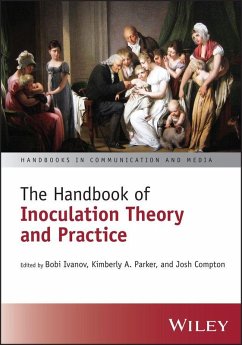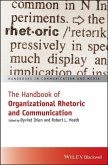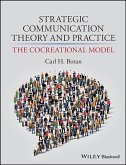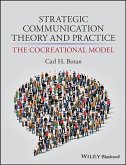Andere Kunden interessierten sich auch für
![The Handbook of Organizational Rhetoric and Communication The Handbook of Organizational Rhetoric and Communication]() O IhlenThe Handbook of Organizational Rhetoric and Communication203,99 €
O IhlenThe Handbook of Organizational Rhetoric and Communication203,99 €![The Handbook of Mental Health Communication The Handbook of Mental Health Communication]() M C. YzerThe Handbook of Mental Health Communication173,99 €
M C. YzerThe Handbook of Mental Health Communication173,99 €![The Dispositif The Dispositif]() Valerie LarrocheThe Dispositif159,99 €
Valerie LarrocheThe Dispositif159,99 €![Strategic Communication Theory and Practice Strategic Communication Theory and Practice]() Carl H BotanStrategic Communication Theory and Practice89,99 €
Carl H BotanStrategic Communication Theory and Practice89,99 €![The Handbook of Financial Communication and Investor Relations The Handbook of Financial Communication and Investor Relations]() AV LaskinThe Handbook of Financial Communication and Investor Relations192,99 €
AV LaskinThe Handbook of Financial Communication and Investor Relations192,99 €![Strategic Communication Theory and Practice Strategic Communication Theory and Practice]() Carl H BotanStrategic Communication Theory and Practice51,99 €
Carl H BotanStrategic Communication Theory and Practice51,99 €![Persuasive Messages Persuasive Messages]() William BenoitPersuasive Messages90,99 €
William BenoitPersuasive Messages90,99 €-
-
-
Produktdetails
- Verlag: Wiley
- Seitenzahl: 432
- Erscheinungstermin: 28. Januar 2026
- Englisch
- ISBN-13: 9781394199358
- ISBN-10: 139419935X
- Artikelnr.: 72807652
- Herstellerkennzeichnung
- Libri GmbH
- Europaallee 1
- 36244 Bad Hersfeld
- gpsr@libri.de
Bobi Ivanov, PhD, is a Professor of Advertising in the College of Journalism and Communications at the University of Florida. His research focuses on social influence, persuasion, and resistance, with an emphasis on inoculation theory, strategic message design, advertising, and risk communication. He has published extensively in leading journals and contributed to advancing inoculation scholarship across multiple domains. Kimberly A. Parker, PhD, is a Professor in the University of Kentucky College of Communication and Information. A former Fulbright Scholar, she studies social influence, persuasive communication, and resistance, with a focus on promoting positive social change. With 25 years of nonprofit collaboration experience, Dr. Parker has published widely and applies her expertise to both academic and applied contexts. Josh Compton, PhD, is Professor of Speech at Dartmouth College. Internationally recognized for his expertise on inoculation theory, he has studied the field for more than two decades, publishing influential work that has sparked conversations among groups as varied as NATO, the U.S. Department of Defense, healthcare professionals, and medievalists.
Introduction
Chapter 1 Origins of Inoculation Theory
Chapter 2 Threat
Chapter 3 Inoculation Theory and Counterarguing
Chapter 4 Inoculation Theory Then and Now: Extending the Boundaries of
Theory and Practice
Chapter 5 Beyond Threat and Counterarguing: A Consideration of Additional
Inoculation Theory Mechanisms
Chapter 6 The Nature of Resistance: Mechanisms in Inoculation Theory
vis-à-vis Alternative Theories/Models
Chapter 7 Exploring the Interplay of Temporal Factors and Resistance within
Inoculation Theory
Chapter 8 Persuasive Inoculation Message Design Features: Style, Language,
Content, and Structure
Chapter 9 Inoculation: Length and Modality
Chapter 10 (Mis)Matching in Inoculation: The Impact of Composition,
Strength, Structure, and Modality Between and Within Established Positions
and Messages
Chapter 11 The Use of Humor and Narratives in the Inoculation Process
Chapter 12 Affect, Motivation, and Resistance in Inoculation
Chapter 13 After Inoculation: Persuasive Attack as the Understudied Second
Pillar
Chapter 14 Inoculation Study Designs, Methods, and Procedures
Chapter 15 Best Practices for Modeling the Inoculation Process
Chapter 16 Inoculation Message Design and Strategic Application
Chapter 17 Consumer Inoculation: The Inoculation Paradigm at the
Consumer-Organization Interface Chapter 18 Public Relations and Corporate
Image: Leveraging Inoculation to Build Trust, Foster Relationships, and
Navigate Reputational Crisis
Chapter 19 Inoculation Theory and Politics
Chapter 20 Preventing Violence through Inoculation: Strategic
Counter-Messaging to Undermine Beliefs and Attitudes that Justify Harm
Chapter 21 Inoculation Strategy for the Promotion of Healthy and the
Prevention of Risky Behaviors
Chapter 22 Inoculation Against Misinformation: Theoretical and Practical
Implications
Chapter 23 Inoculation Theory at the Intersection of Disasters and
Catastrophes
Chapter 24 Inoculation Theory, Family, and Interpersonal Relationships
Chapter 25 Inoculation Theory and the Media
Chapter 26 Inoculation and Culture
Chapter 27 Inoculation Theory and Legal Communication
Chapter 28 Inoculation in Education, Instruction, and Training Contexts
Chapter 29 Inoculation Theory and Sport, Exercise, and Physical Activity
Chapter 30 Inoculation in Organizations, the Workplace, and Small Groups:
Current and Future Directions
Chapter 31 Inoculation Theory and the Communication of Scientific Findings
Chapter 32 Inoculation Theory and Public Policy
Chapter 33 Additional Issues and Topics in Inoculation Theory Research
Conclusion
Chapter 1 Origins of Inoculation Theory
Chapter 2 Threat
Chapter 3 Inoculation Theory and Counterarguing
Chapter 4 Inoculation Theory Then and Now: Extending the Boundaries of
Theory and Practice
Chapter 5 Beyond Threat and Counterarguing: A Consideration of Additional
Inoculation Theory Mechanisms
Chapter 6 The Nature of Resistance: Mechanisms in Inoculation Theory
vis-à-vis Alternative Theories/Models
Chapter 7 Exploring the Interplay of Temporal Factors and Resistance within
Inoculation Theory
Chapter 8 Persuasive Inoculation Message Design Features: Style, Language,
Content, and Structure
Chapter 9 Inoculation: Length and Modality
Chapter 10 (Mis)Matching in Inoculation: The Impact of Composition,
Strength, Structure, and Modality Between and Within Established Positions
and Messages
Chapter 11 The Use of Humor and Narratives in the Inoculation Process
Chapter 12 Affect, Motivation, and Resistance in Inoculation
Chapter 13 After Inoculation: Persuasive Attack as the Understudied Second
Pillar
Chapter 14 Inoculation Study Designs, Methods, and Procedures
Chapter 15 Best Practices for Modeling the Inoculation Process
Chapter 16 Inoculation Message Design and Strategic Application
Chapter 17 Consumer Inoculation: The Inoculation Paradigm at the
Consumer-Organization Interface Chapter 18 Public Relations and Corporate
Image: Leveraging Inoculation to Build Trust, Foster Relationships, and
Navigate Reputational Crisis
Chapter 19 Inoculation Theory and Politics
Chapter 20 Preventing Violence through Inoculation: Strategic
Counter-Messaging to Undermine Beliefs and Attitudes that Justify Harm
Chapter 21 Inoculation Strategy for the Promotion of Healthy and the
Prevention of Risky Behaviors
Chapter 22 Inoculation Against Misinformation: Theoretical and Practical
Implications
Chapter 23 Inoculation Theory at the Intersection of Disasters and
Catastrophes
Chapter 24 Inoculation Theory, Family, and Interpersonal Relationships
Chapter 25 Inoculation Theory and the Media
Chapter 26 Inoculation and Culture
Chapter 27 Inoculation Theory and Legal Communication
Chapter 28 Inoculation in Education, Instruction, and Training Contexts
Chapter 29 Inoculation Theory and Sport, Exercise, and Physical Activity
Chapter 30 Inoculation in Organizations, the Workplace, and Small Groups:
Current and Future Directions
Chapter 31 Inoculation Theory and the Communication of Scientific Findings
Chapter 32 Inoculation Theory and Public Policy
Chapter 33 Additional Issues and Topics in Inoculation Theory Research
Conclusion
Introduction
Chapter 1 Origins of Inoculation Theory
Chapter 2 Threat
Chapter 3 Inoculation Theory and Counterarguing
Chapter 4 Inoculation Theory Then and Now: Extending the Boundaries of
Theory and Practice
Chapter 5 Beyond Threat and Counterarguing: A Consideration of Additional
Inoculation Theory Mechanisms
Chapter 6 The Nature of Resistance: Mechanisms in Inoculation Theory
vis-à-vis Alternative Theories/Models
Chapter 7 Exploring the Interplay of Temporal Factors and Resistance within
Inoculation Theory
Chapter 8 Persuasive Inoculation Message Design Features: Style, Language,
Content, and Structure
Chapter 9 Inoculation: Length and Modality
Chapter 10 (Mis)Matching in Inoculation: The Impact of Composition,
Strength, Structure, and Modality Between and Within Established Positions
and Messages
Chapter 11 The Use of Humor and Narratives in the Inoculation Process
Chapter 12 Affect, Motivation, and Resistance in Inoculation
Chapter 13 After Inoculation: Persuasive Attack as the Understudied Second
Pillar
Chapter 14 Inoculation Study Designs, Methods, and Procedures
Chapter 15 Best Practices for Modeling the Inoculation Process
Chapter 16 Inoculation Message Design and Strategic Application
Chapter 17 Consumer Inoculation: The Inoculation Paradigm at the
Consumer-Organization Interface Chapter 18 Public Relations and Corporate
Image: Leveraging Inoculation to Build Trust, Foster Relationships, and
Navigate Reputational Crisis
Chapter 19 Inoculation Theory and Politics
Chapter 20 Preventing Violence through Inoculation: Strategic
Counter-Messaging to Undermine Beliefs and Attitudes that Justify Harm
Chapter 21 Inoculation Strategy for the Promotion of Healthy and the
Prevention of Risky Behaviors
Chapter 22 Inoculation Against Misinformation: Theoretical and Practical
Implications
Chapter 23 Inoculation Theory at the Intersection of Disasters and
Catastrophes
Chapter 24 Inoculation Theory, Family, and Interpersonal Relationships
Chapter 25 Inoculation Theory and the Media
Chapter 26 Inoculation and Culture
Chapter 27 Inoculation Theory and Legal Communication
Chapter 28 Inoculation in Education, Instruction, and Training Contexts
Chapter 29 Inoculation Theory and Sport, Exercise, and Physical Activity
Chapter 30 Inoculation in Organizations, the Workplace, and Small Groups:
Current and Future Directions
Chapter 31 Inoculation Theory and the Communication of Scientific Findings
Chapter 32 Inoculation Theory and Public Policy
Chapter 33 Additional Issues and Topics in Inoculation Theory Research
Conclusion
Chapter 1 Origins of Inoculation Theory
Chapter 2 Threat
Chapter 3 Inoculation Theory and Counterarguing
Chapter 4 Inoculation Theory Then and Now: Extending the Boundaries of
Theory and Practice
Chapter 5 Beyond Threat and Counterarguing: A Consideration of Additional
Inoculation Theory Mechanisms
Chapter 6 The Nature of Resistance: Mechanisms in Inoculation Theory
vis-à-vis Alternative Theories/Models
Chapter 7 Exploring the Interplay of Temporal Factors and Resistance within
Inoculation Theory
Chapter 8 Persuasive Inoculation Message Design Features: Style, Language,
Content, and Structure
Chapter 9 Inoculation: Length and Modality
Chapter 10 (Mis)Matching in Inoculation: The Impact of Composition,
Strength, Structure, and Modality Between and Within Established Positions
and Messages
Chapter 11 The Use of Humor and Narratives in the Inoculation Process
Chapter 12 Affect, Motivation, and Resistance in Inoculation
Chapter 13 After Inoculation: Persuasive Attack as the Understudied Second
Pillar
Chapter 14 Inoculation Study Designs, Methods, and Procedures
Chapter 15 Best Practices for Modeling the Inoculation Process
Chapter 16 Inoculation Message Design and Strategic Application
Chapter 17 Consumer Inoculation: The Inoculation Paradigm at the
Consumer-Organization Interface Chapter 18 Public Relations and Corporate
Image: Leveraging Inoculation to Build Trust, Foster Relationships, and
Navigate Reputational Crisis
Chapter 19 Inoculation Theory and Politics
Chapter 20 Preventing Violence through Inoculation: Strategic
Counter-Messaging to Undermine Beliefs and Attitudes that Justify Harm
Chapter 21 Inoculation Strategy for the Promotion of Healthy and the
Prevention of Risky Behaviors
Chapter 22 Inoculation Against Misinformation: Theoretical and Practical
Implications
Chapter 23 Inoculation Theory at the Intersection of Disasters and
Catastrophes
Chapter 24 Inoculation Theory, Family, and Interpersonal Relationships
Chapter 25 Inoculation Theory and the Media
Chapter 26 Inoculation and Culture
Chapter 27 Inoculation Theory and Legal Communication
Chapter 28 Inoculation in Education, Instruction, and Training Contexts
Chapter 29 Inoculation Theory and Sport, Exercise, and Physical Activity
Chapter 30 Inoculation in Organizations, the Workplace, and Small Groups:
Current and Future Directions
Chapter 31 Inoculation Theory and the Communication of Scientific Findings
Chapter 32 Inoculation Theory and Public Policy
Chapter 33 Additional Issues and Topics in Inoculation Theory Research
Conclusion








